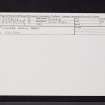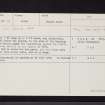Pricing Change
New pricing for orders of material from this site will come into place shortly. Charges for supply of digital images, digitisation on demand, prints and licensing will be altered.
Coupar Angus Abbey
Archaeological Feature(S) (Period Unknown), Linear Feature(S) (Period Unknown), Long Cist (Early Medieval)
Site Name Coupar Angus Abbey
Classification Archaeological Feature(S) (Period Unknown), Linear Feature(S) (Period Unknown), Long Cist (Early Medieval)
Canmore ID 30558
Site Number NO23NW 14
NGR NO 2237 3979
NGR Description NO 2237 3979 - NO 2245 3980
Datum OSGB36 - NGR
Permalink http://canmore.org.uk/site/30558
- Council Perth And Kinross
- Parish Coupar Angus
- Former Region Tayside
- Former District Perth And Kinross
- Former County Perthshire
NO23NW 14 2237 3979.
A cist, c.7ft long by c.2ft broad, was discovered, about 6ft below the ground, in the area of the burying- ground at Coupar Angus but 'apparently beyond the limits of the abbey walls', in the summer of 1887. It had no cover but was paved, and the sides were made up of blue stone slabs, set up on edge.
A Hutcheson 1888
The burying-ground is centred at NO 2237 3979. No further information.
Visited by OS (EGC) 17 February 1969
Project (July 2007 - October 2007)
NO 2237 3979 In the churchyard a vaguely cruciform area of high resistivity ground has been mapped to the E of the present church. This corresponds to a slight topographic feature and has a much more ‘manmade’ appearance than an area of high resistance mapped in the adjacent Glebe field which excavation suggested is due to a dump of uplifted stony subsoil (from digging foundations?). Resistivity profiling results suggest that the churchyard anomaly is due to a layer of high resistivity material 1–1.5m thick. This might be associated either with the abbey or with the previous parish church (1686–1869). The magnetic survey undertaken in July to August 2007 was very noisy, as expected in a graveyard, but there are suggestions of some linear features; the most prominent of these can be seen extending into the area of the old 1975 magnetic survey in the field to the E. No anomalies have yet been found in any of the surveys in the area which can be confidently associated with part of the abbey buildings. Resistivity work has recently been started (October 2007) in the field to the S of the churchyard. Preliminary results show evidence for the presence of a building immediately to the S of the churchyard wall together with a series of low resistance linear features which may represent ditches or drains.
Archive to be deposited with RCAHMS.
Resistivity (July 2007 - October 2007)
NO 2237 3979 Resistivity survey.
Archive to be deposited with RCAHMS.
Magnetometry (July 2007 - October 2007)
NO 2237 3979 Magnetometry survey.
Archive to be deposited with RCAHMS.
Project (10 September 2009 - 16 October 2009)
NO 2245 3980 The resistivity survey of the field to the S and E of Coupar Angus Abbey Church churchyard, left unfinished in 2007, was completed. A magnetic gradiometer survey was then conducted over the whole of this field. The work was carried out from 10 September–16 October 2009. The southern half of the magnetic map reveals a series of linear features which probably represent ditches of some sort, either field boundaries or drains. They seem to end at a boundary ditch along the side of Thorn Alley. A strip of data along the E side of the alley failed to find convincing evidence for any continuation into that area. Some of these features have been in existence since 1975 as they can be seen on a magnetic survey conducted over part of the field (Ancient Monuments Laboratory) in that year. There remains the intriguing possibility that they are ancient and relate to the former Abbey. An even stronger candidate for an Abbey feature can be found immediately to the S of the southern churchyard wall. Here resistivity suggests the presence of a rectangular structure at least 20 x 15m. This is associated with a complex patch of linear magnetic anomalies which possibly represent some form of associated drainage system (or robber trenches). The presence of abundant red sandstone chips in the topsoil, not seen elsewhere in the field, again indicates that walls existed here. Nothing is shown at this position on the earliest largescale OS maps, suggesting that the structure is relatively old. The northern part of the field is cut by a large linear magnetic anomaly which seems to mark the position of a pipeline. A parallel zone of anomalies immediately to the N of this appears to represent spoil from the pipeline trench. Further N is a quieter magnetic zone where resistivity suggests the presence of a rectangular feature at least 40 x 30m aligned with the N and E field boundaries.
Archive: RCAHMS, Perth and Kinross SMR (intended)
Funder: Blairgowrie Geoscience
P Morris – Blairgowrie Geoscience
Magnetometry (10 September 2009 - 16 October 2009)
NO 2245 3980 Magnetometry survey.
Archive: RCAHMS, Perth and Kinross SMR (intended)
Funder: Blairgowrie Geoscience
P Morris – Blairgowrie Geoscience
Resistivity (10 September 2009 - 16 October 2009)
NO 2245 3980 Resistivity survey.
Archive: RCAHMS, Perth and Kinross SMR (intended)
Funder: Blairgowrie Geoscience
P Morris – Blairgowrie Geoscience
Resistivity (25 July 2011 - 20 August 2011)
NO 2235 3980 The previous geophysical surveys in Coupar Angus churchyard have not provided much evidence of the important Cistercian Abbey that is assumed to have existed in this area. As the site consists of mostly made ground, which has been built up by several hundred years worth of burials, it is possible that the surveys had not reached the remains. A grid of 16 electrical resistance tomography profiles with c10m spacing was measured in the churchyard, 25 July–20 August 2011, and provided information down to c2m below the current ground surface. Though no really clear indications of abbey structures were found, the general resistivity picture is very much what one might expect from a heavily robbed abbey site, with a cloister in the western part of the graveyard and monastic buildings around it.
Archive: Perth and Kinross SMR and RCAHMS (intended)
Funder: Perth and Kinross Heritage Trust
Blairgowrie Geoscience, 2011










